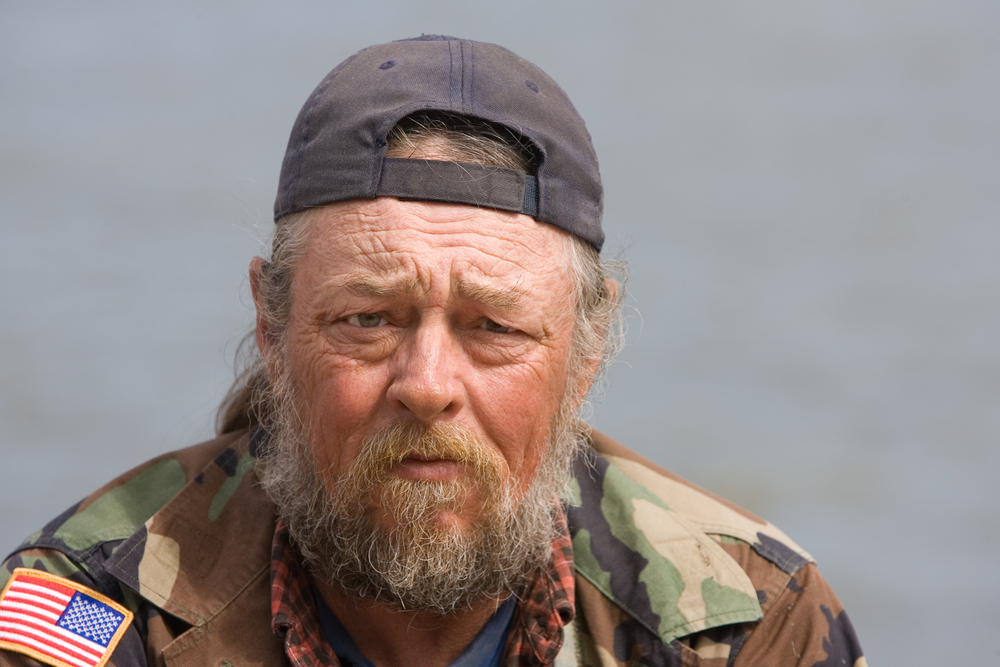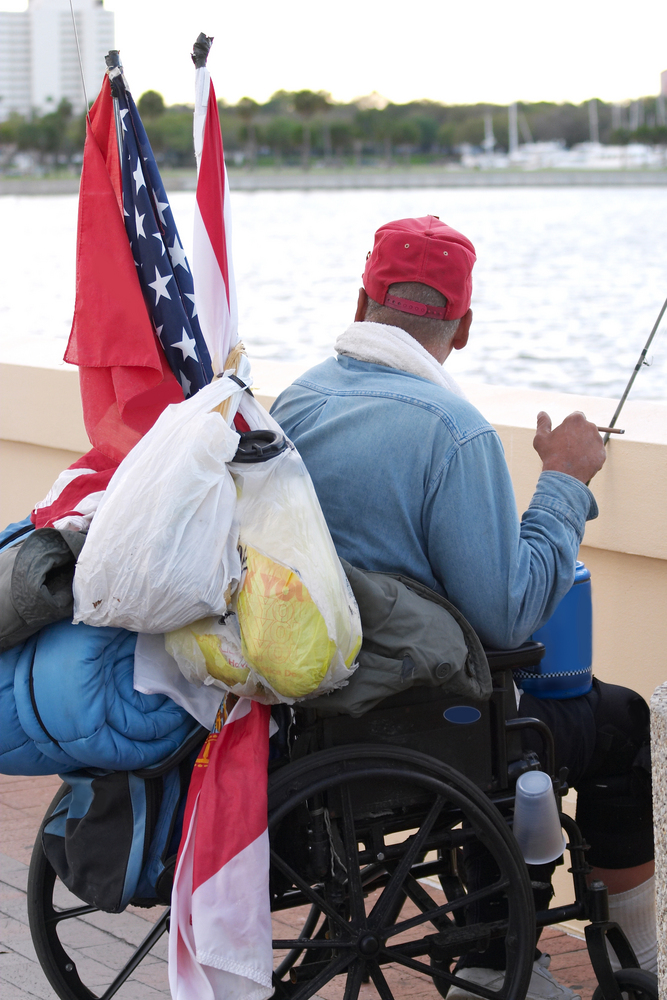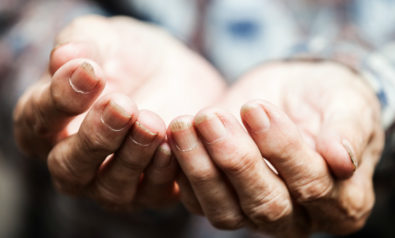US government efforts to help homeless veterans in America are not enough.
When I first began grappling with homelessness issues in my local community quite a number of years ago, Dave, then-director of the local homeless shelter in our small town, told me a story that illustrates some of the special circumstances faced by homeless veterans in America.
Dave said a community of homeless vets had based themselves in caves in the hills outside of town, and after one was stricken with pneumonia and had to be hospitalized, his ongoing recovery left health care providers with a thorny dilemma. Clearly, the man was ready to be released from the hospital, but they were loathe to send a recovering pneumonia patient to his home in the caves.
In the end, they called Dave, released the patient into the care of the homeless shelter, and in short order the man’s buddies came down from the hills and reclaimed their comrade, who went back up to the caves to rejoin his community.
Loose Ends
This story has all the earmarks of a great urban legend, although I have every reason to believe that Dave was telling the truth. The point is much darker and speaks to fundamental truths about homeless veterans in America: Men and women, who may have thrived in the close-knit environs and shared sense of mission within the military community, sometimes find themselves at loose ends in the midst of a population that doesn’t seem to know or care very much about their special needs.
Many veterans suffer from post-traumatic stress disorder (PSTD) and other maladies, and may self-medicate with drugs and alcohol as a result. Drug and alcohol use and mental illness tear away at the social fabric, the “kin network,” the community of family and friends we all rely upon to help us through tough times.
Any of us who have suffered through a breakdown — either as a direct victim or as a veteran’s close friend or relative — knows how gutting this process can be. Veterans are especially vulnerable to this downward spiral, which often ends on the streets.
Every study of the situation yields different numbers. According to the National Coalition for the Homeless, on any given night as many as 144,000 vets may be homeless. (The National Coalition for Homeless Veterans asserts that this figure is dated, and would revise it downward significantly.)
Literally hundreds of thousands of men and women who served in uniform teeter on the edge of homelessness. According to the National Coalition for Homeless Veterans, “1.4 million other veterans, meanwhile, are considered at risk of homelessness due to poverty, lack of support networks, and dismal living conditions in overcrowded or substandard housing.”
Annual “point-in-time” counts take a “snap-shot” approach, attempting to number all homeless individuals who can be found on a given winter night in shelters, on the streets, etc. Almost by definition these counts have severe limitations, but they can prove useful barometers. The US Department of Housing and Urban Development reports that on a single night in January 2013, 57,849 veterans were homeless; 4,456 were women. Sixty percent of these were in shelters, while the remaining amount “were in unsheltered locations,” which generally means on the streets. This means we know for certain that, at the very least, 23,000 American veterans put their heads down on the pavement on a cold winter night.
In and Out of Shelters
That’s just the tip of the iceberg. Many homeless people are in and out of shelters, bunking with friends, sleeping in cars or camping out in parks and vacant lots. This is hardly just an urban phenomenon either. I personally know quite a few folks who camp out more-or-less permanently in the woods in my rural Pennsylvania county. Many people without housing attempt to avoid the stigma of being labeled “homeless,” and this can prove especially true of older veterans, many of whom have become wary of engaging the government services available to them.
Our veterans living in poverty, like other struggling Americans, have been stung even more severely by the recent economic downturn. They face conditions such as a lack of affordable housing, especially in our urban centers. Wages are often simply not high enough to keep working poor folks in traditional housing.
Veterans often deal with additional risk factors. The National Coalition for Homeless Veterans reports: “A large number of displaced and at-risk veterans live with lingering effects of post-traumatic stress disorder (PTSD) and substance abuse, which are compounded by a lack of family and social support networks.” Vets also often find themselves with military occupational skills, which are not readily transferable to civilian employment.
Our first order of business in this regard must be to find secure and safe housing for every veteran who requires it; in the words of the National Coalition for Homeless Veterans: “A top priority for homeless veterans is secure, safe, clean housing that offers a supportive environment free of drugs and alcohol.”
The Veterans Administration (VA) has taken its charge to deal with these problems seriously, and provides health care to nearly 150,000 homeless veterans annually. In addition, some 40,000 homeless veterans receive monthly benefits. But the VA recognized more than a quarter of a century ago that federal agencies on their own cannot eradicate these problems. Indeed, beginning in 1987, the VA has emphasized partnerships with local agencies, and such initiatives have garnered real successes, reportedly reducing the number of homeless veterans by 70% over the last decade.
Ending Homelessness Among Veterans
In November 2009, at the National Summit on Ending Veterans Homelessness, Department of Veterans Affairs Secretary Eric Shinseki announced the goal of ending homelessness among veterans by 2015. Shinseki also offered a plan for achieving this goal. In response, seven months later the US Interagency Council on Homelessness (USICH) published Opening Doors: Federal Strategic Plan to Prevent and End Homelessness, which was designed to align with Shinseki’s plan.
Largely as a result of these efforts, the number of homeless veterans has declined significantly. Some studies indicate that perhaps as many as 24% of homeless veterans — 17,760 — were housed between 2009 and 2013.
That’s the good news; the bad news is these efforts, laudable though they certainly are, do not go nearly far enough. In the words of the National Coalition for the Homeless: “These programs do not meet the current existing need.” This is especially true in regard to shoring up the situations of those veterans who may not be currently homeless, but who are at risk for becoming so.
Literally hundreds of thousands of men and women who served in uniform teeter on the edge of homelessness. According to the National Coalition for Homeless Veterans, “1.4 million other veterans, meanwhile, are considered at risk of homelessness due to poverty, lack of support networks, and dismal living conditions in overcrowded or substandard housing.”
Concrete Steps
The National Coalition for Homeless Veterans offers a number of concrete steps each of us can take. First, investigate the local need and the agencies addressing that need. Second, get involved and involve others. Third, find and join your local homeless coalition. Fourth, give as generously as possible to those providers you determine are most worthy. Fifth, inform your elected representatives of the problems and possible solutions.
Although the timetable suggested by the VA and USICH may well prove too optimistic, and although the challenges that remain are substantial, providing safe homes and appropriate services to all US veterans may indeed be an achievable goal.
It is not enough simply to sit back and expect the government to provide all that is necessary to help the most imperiled of our veterans. The National Coalition for Homeless Veterans notes: “The most effective programs for homeless and at-risk veterans are community-based, nonprofit, ‘veterans helping veterans’ groups. Programs that seem to work best feature transitional housing with the camaraderie of living in structured, substance-free environments with fellow veterans who are succeeding at bettering themselves.” Helping vets to find, obtain and maintain stable employment at a livable wage is also a key factor necessary for success, and job retraining is often a necessary component of the process.
In short, it is necessary for all of us to step up: Uncle Sam wants you to help end homelessness among American veterans.
The views expressed in this article are the author’s own and do not necessarily reflect Fair Observer’s editorial policy.
Brian Eichhorn / Lisa F. Young / Shutterstock.com
Support Fair Observer
We rely on your support for our independence, diversity and quality.
For more than 10 years, Fair Observer has been free, fair and independent. No billionaire owns us, no advertisers control us. We are a reader-supported nonprofit. Unlike many other publications, we keep our content free for readers regardless of where they live or whether they can afford to pay. We have no paywalls and no ads.
In the post-truth era of fake news, echo chambers and filter bubbles, we publish a plurality of perspectives from around the world. Anyone can publish with us, but everyone goes through a rigorous editorial process. So, you get fact-checked, well-reasoned content instead of noise.
We publish 3,000+ voices from 90+ countries. We also conduct education and training programs
on subjects ranging from digital media and journalism to writing and critical thinking. This
doesn’t come cheap. Servers, editors, trainers and web developers cost
money.
Please consider supporting us on a regular basis as a recurring donor or a
sustaining member.
Will you support FO’s journalism?
We rely on your support for our independence, diversity and quality.
















Comment
Homeless Veterans want REGULAR HOUSING, with standard leases, keys to locking doors, and PRIVACY to live their lives as they see fit.
“secure, safe, clean housing that offers a supportive environment free of drugs and alcohol” = PRISON-LIKE HELL-HOLES
Better than nothing, no?